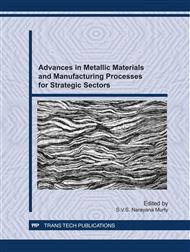p.439
p.445
p.451
p.457
p.463
p.471
p.477
p.483
p.489
Effect of Ultrasonic Treatment on the Grain Refinement and Mechanical Properties of AZ91 Magnesium Alloy
Abstract:
The present study examines the microstructural evolution and mechanical properties of AZ91 magnesium alloy solidified under high intensity ultrasonic treatment (UST). High intensity ultrasonic vibrations were introduced isothermally below the liquidus temperature into the solidifying AZ91 alloy for the refinement of primary α-Mg grains and β-Mg17Al12 intermetallic phase. Various microstructures were produced using different intensity of ultrasonic vibration at a constant temperature and fixed duration of UST. Without any ultrasonic treatment, the structure contains dendrites of primary α-Mg phase which are coarser and non-uniform in size. Nearly uniform, equiaxed grains with continuous and uniform network of intermetallic phase segregated along the grain boundaries were obtained in alloy subjected to high intensity ultrasonic vibration. The average grain size in this case decreased drastically from 300 μm for (without UST) to 17 μm (with UST at intensity of 4 kW/cm2). Vickers hardness also increased steadily with increase in ultrasonic intensity. The mechanisms for microstructural refinement are discussed and it is concluded that the fine uniform grain structure achieved under ultrasonic vibrations is attributed to the cavitation and the acoustic flow induced by ultrasonic vibrations.
Info:
Periodical:
Pages:
463-468
Citation:
Online since:
January 2012
Authors:
Price:
Сopyright:
© 2012 Trans Tech Publications Ltd. All Rights Reserved
Share:
Citation:


